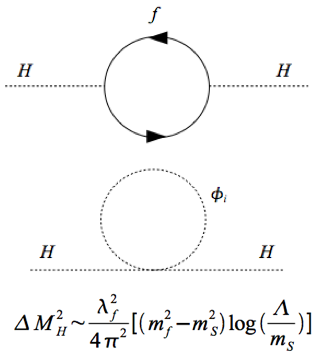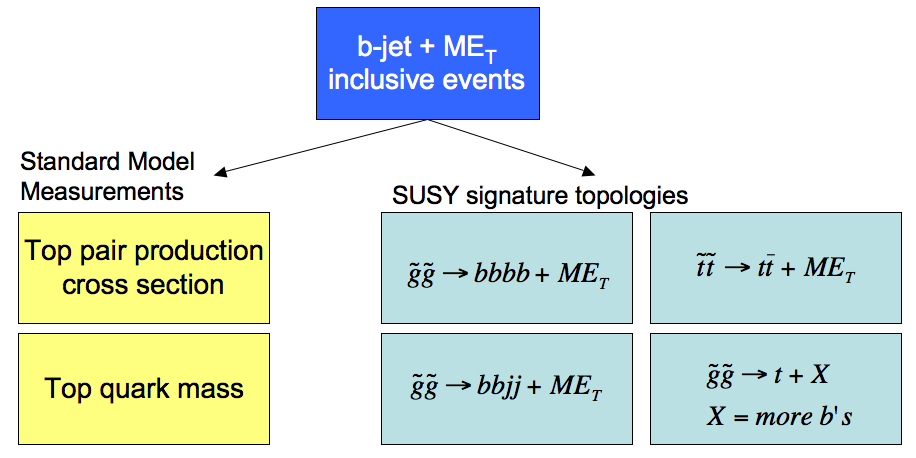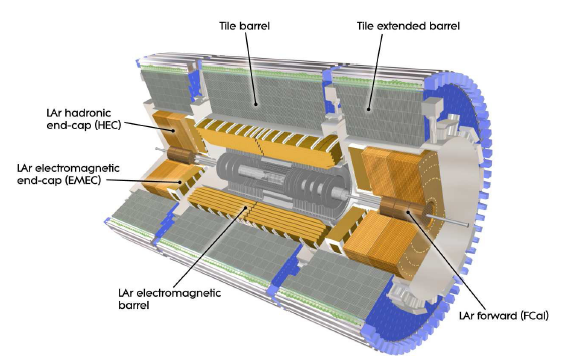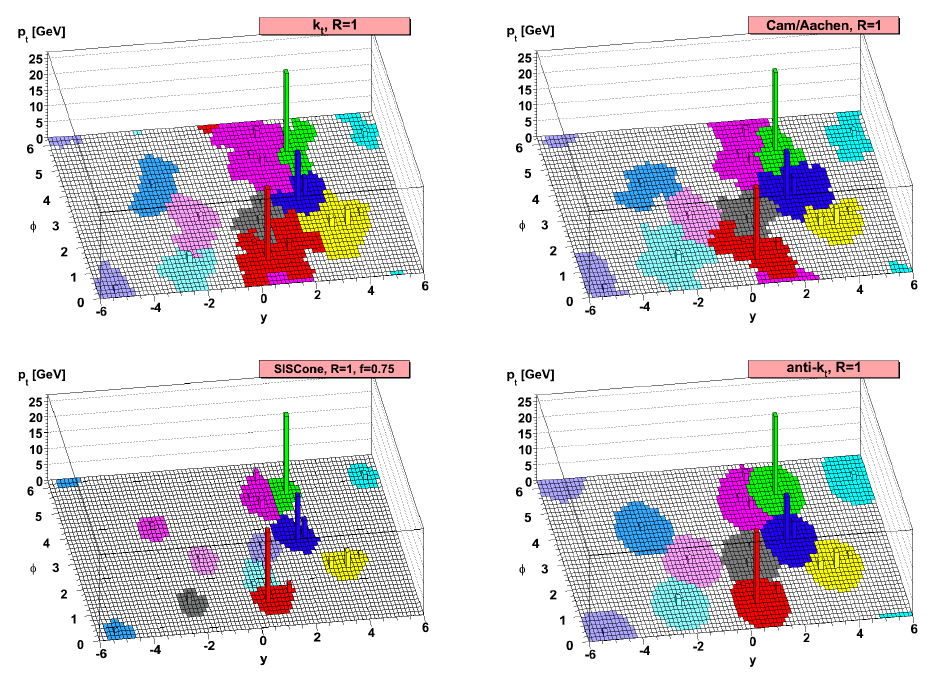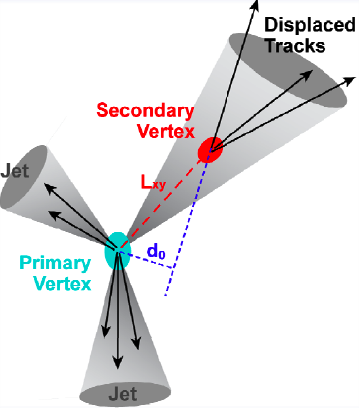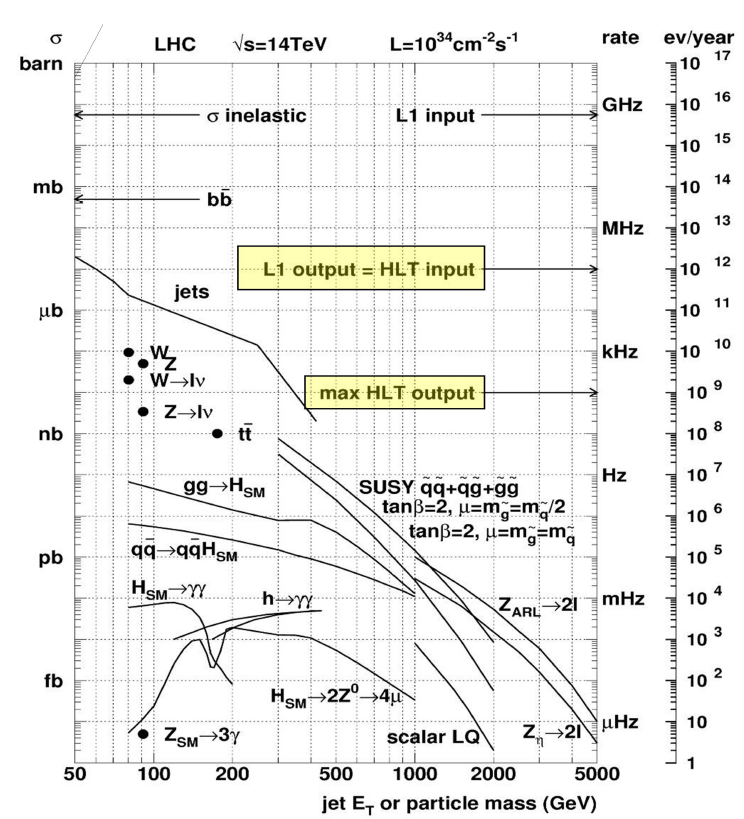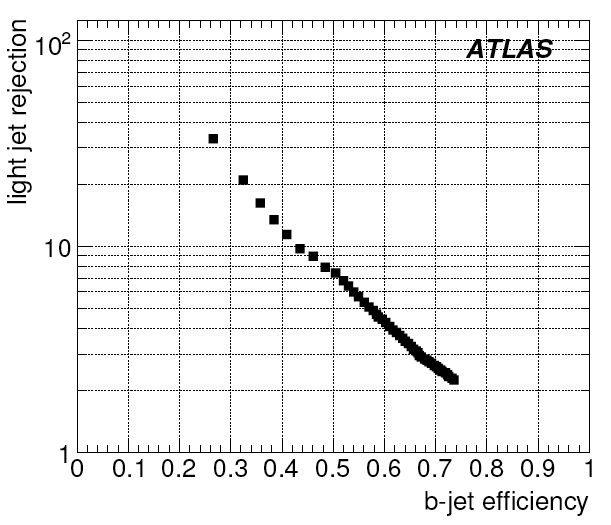b+Jet+MET topology-based physics signatures
Super-symmetry (SUSY) is one of the most attractive extensions of the Standard Model. It provides solutions to the hierarchy problem and the unification of the gauge forces, and a natural candidate for the dark matter in the Universe.
Squarks and gluinos (super-partners of quarks and gluons), if they exist, will be copiously produced at the LHC via the strong interaction. Squark and gluino production leads to signatures with multi-jets through cascade decays and the neutral LSP, which escapes detection resulting in large transverse missing energy (missing ET). Hence, Jets+missing ET is the dominant experimental signature for SUSY, with the highest discovery reach.
While most SUSY searches focus on particular points in the parameter space of SUSY models, our group is developing a broad research program based on physics signatures containing multi-b jets and missing ET in the final state. This includes understanding (and measuring) Standard Model processes and probing SUSY in this final state signature.
The requirement of b-jets in events with large missing ET and multi-jets is well motivated both theoretically and experimentally:
- QCD, and WZ+(light quark) jets backgrounds are significantly reduced.
- Top background is irreducible, but b-tagging provides additional handles to control and measure it.
- Reducing non-top SM backgrounds by requiring b-tags could be one of the keys to the early discovery of SUSY at the LHC.
- In many scenarios, where the third-generation of squarks are expected to be light, most new physics events will contain two or four b- or t-quarks.
- Even if SUSY is first discovered in inclusive jet + MET or lepton events, understanding the production of third-generation squarks will be critical to answer important physics questions.
- Is new physics related to Dark Matter? since b-tags reduce the QCD multi-jet background, looser MET cuts can open up the possibility to study the shape of the MET, to determine if the missing energy originates from a massive object.
- Quadratic divergences in the top sector: third-generation squarks (stops, sbottoms) are responsible for the largest quantum corrections that stabilize the weak scale. b-tagging can help determine the mass scale for third-generation partners.
- Origin of the electroweak symmetry breaking: if third-generation partners are light, higgs particles can be produced in decay chains starting with stops and sbottoms, as well as in gluino decays. A light Higgs could be first discovered in this channel.
The b+MET signature is almost unexplored in ATLAS: b-tag and missing ET are among the most challenging and complex techniques. Expertise in multiple areas is required, which matches well SLAC strengths.
There are several experimental challenges to b+MET analyses:
- Efficient b-tag trigger to afford lower missing ET and jet pT requirements (to increase the event selection efficiency)
- Jet energy scale and resolution, and the effect of multiple interactions.
- Missing ET clean up, calibration, and significance. In particular, in the presence of b-jets in the final state.
- b-tagging:
- b-tag background estimation at high tag multiplicities.
- Estimation of b production from gluon splitting.
- b/c flavor separation.
- high pT b-tagging
Our group is heavily involved in all these areas is making significant contributions to ATLAS reconstruction software and analysis.
An overview of the b+Jet+MET topology-based research can be found in the diagram and links below.
Top quark cross section measurement in the missing ET + b-jet channel
Verifying top x section and mass and probing for SUSY at the same time.
Inclusive missing ET + multi-b search
missing ET + 4b analysis
Top + b
Top + MET
ttH
Jet reconstruction, calibration, and resolution
introduction...
Jet algorithms
Inputs to jet reconstruction: Calorimeter towers with noise suppression (TopoTowers)
Track-jets
Jet energy resolution improvements using tracks
Jet energy resolution improvements using longitudinal calorimeter segmentation
Jet-Vertex association algorithm
Baseline correction for pile-up and noise
Semi-leptonic b-jet energy scale
Measurement of the jet energy resolution
b-tagging
Using the precise track reconstruction of the ATLAS inner detector, it is possible to identify jets arising from b quark hadronization by reconstructing the decay vertex of long-lived B hadrons within the jet.
The decay of a long-lived hadron produces several charged particles emanating from a secondary vertex, displaced from the primary interaction point. b-tagging plays a major role on top quark identi?cation and searches for the Higgs boson and Super-symmetry.
Our group is investigating the use of track-based (instead of calorimeter based) jets to feed the b-tagging algorithms, event tagging, and high pT b-jet tagging.
Track-jet based b-tagging
High pT b-tagging
Event Tagging
Hadronic flavor tagging
The aim of this research program is to develop techniques to identify the flavor of hadronic jets, in particular: quark/gluon separation, tagging b-jets from gluon splitting, and the identification of highly boosted (bb) jets.
Gluon bb tagging
The SLAC group has proposed, for the ?rst time in an hadron collider experiment, a technique to identify b-tagged jets from gluon splitting, and distinguish them from single b-tagged jets. This is important because the main backgrounds containing b?jets to signals from new physics, as well as for single-top, and Higgs production, consist of the production of a W boson in association with b?quarks produced by gluon splitting.
Next-to-leading order calculations show that, at the LHC, the cross section for merged b?jets is a factor of two higher compared to the
case in which the two b?quarks are produced at larger angles and reconstructed as separate jets.
The method developed uses a Neural Network (NN) trained with tracking and calorimeter information based on the fact that merged (bb) jets are wider, and have larger calorimeter-cluster and track multiplicity than single b jets.
We plan to use this neural network to select control samples with different gluon splitting content to test data/Monte Carlo agreement, reject b-tag background events, and improve the estimation of b-tag backgrounds.
Highly boosted (bb)-jets
Very recently it has been proposed that (low mass) Higgs production in association with W boson could be efficiently identified at the LHC if the Higgs is produced with high transverse momentum. Highly boosted Higgs decaying to b-quarks produce a signature of merged (bb)-jets, which can be distinguished from generic QCD jets.
The original paper proposes a method based on jet sub-structure to separate (bb) jets from QCD jets. We would like to investigate the use of a neural network technique, similar to the gbb NN developed to separate gluon->(bb) jets from b-jets, and study the kinematic differences of merged (bb) jets from gluon splitting and merged (bb) jets from Higgs.
Quark/gluon separation
We are working in the development of a neural network based algorithm that assigns jets a probability that they originated from quarks or gluons, based on Monte Carlo simulations.
There are several analysis and problems that can benefit from this technique, in particular:
- Validation of jet energy scale on quark/gluon enhanced data samples.
- Improve the understanding of Standard Model backgrounds: ttbar+jets.
- Use flavor tagging to improve inclusive Super-symmetric jet+met searches: reduce the QCD background by rejecting quark-like jets.
High Level Trigger b-tagging
The LHC will produce collisions at a rate of 40MHz. The purpose of the trigger system is to reduce the output event storage rate to about 300MB/s or approximately 200Hz.
Since most of the collisions at the LHC center of mass energy will result in non-interesting physics events, such QCD multi-jet production, the main task of the trigger system is to reject QCD events while maintaining high efficiency for low cross section processes like Super-symmetry, Higgs, etc.
The ATLAS trigger consists of three levels: Level 1, which is hardware based, and the high level trigger (HLT) which consists of Level 2, and the Event Filter. The HLT is based on software algorithms that analyze region of interests (RoI) identified by the level 1 trigger. The output rates of the three trigger levels are 75KHZ, 2KHz, 200Hz.
Tagging b-jets at the trigger level can expand the physics reach of ATLAS in many ways: it allows to lower the jet ET threshold to increase the acceptance of interesting physics events containing multiple b-jets (like bbH and ttH ), and can be used to reduce non-b backgrounds and improve the purity of Super-symmetry searches involving b-jets in the ?nal state.
The SLAC group has implemented one of the two ATLAS b-tagging algorithms at level 2 trigger: the Impact Parameter ?2 Probability tagger (IPChi2)
Level 2 impact parameter Chi2 algorithm
The IPChi2 tagger is based on the impact parameter distribution of mis-tags, which can be derived directly from data and does not require the use of Monte Carlo templates as in the likelihood ratio b-tagger.
For every region of interest selected by the level 1 trigger, the level 2 b-tagging algorithm uses tracks reconstructed by the level 2 trigger, to determine the probability that the RoI originates form the primary vertex. b-jets are identified by chi2 probability cut.
The performance is measured as rejection as a function of efficiency. For instance, for a b-tagging efficiency of 60%, the Level 2 b-tagging algorithm rejection is 4, which means that, on average, only one out of four light quark jets will pass the selection.
link to ATLAS page
b-jet trigger menu
We are working in the design of different trigger chains (set of trigger signatures and operational points at Level 1, Level 2 and Event Filter) optimized for different physics analyses, in particular all hadronic top, and inclusive jet+MET and b+MET searches.
In particular, we are investigating the performance of asymmetric double b-tagging, which consists of requiring one loose and one tight b-tag jets. We have seen that this type of selection improves the rejection (at a same efficiency) compared to the more standard symmetric tagging.
b+MET combined trigger
The SLAC group has proposed a combined b-jet+MET trigger, to be used in physics signatures containing b-jets and missing ET. The missing ET requirement provides an additional handle to reduce the output rate, while maintaining high efficiency for signal events.
We are currently studying the effect of this trigger signature in hadronic top quark final states, and b+MET Super-symmetric events.
